To create wild herb tea, start by foraging responsibly for herbs like chamomile or mint, ensuring you identify them correctly. Harvest in the right season—spring for tender leaves, summer for flowers, and autumn for roots. Clean your herbs gently, using water to remove dirt. Dry them using air drying, dehydrators, or even a microwave. When you're brewing, steep one teaspoon of dried herbs in hot water for a few minutes. Finally, enhance with citrus or honey for added flavor. Each step is essential for a delicious cup, and there's plenty more to discover about the process ahead.
Selecting Wild Herbs
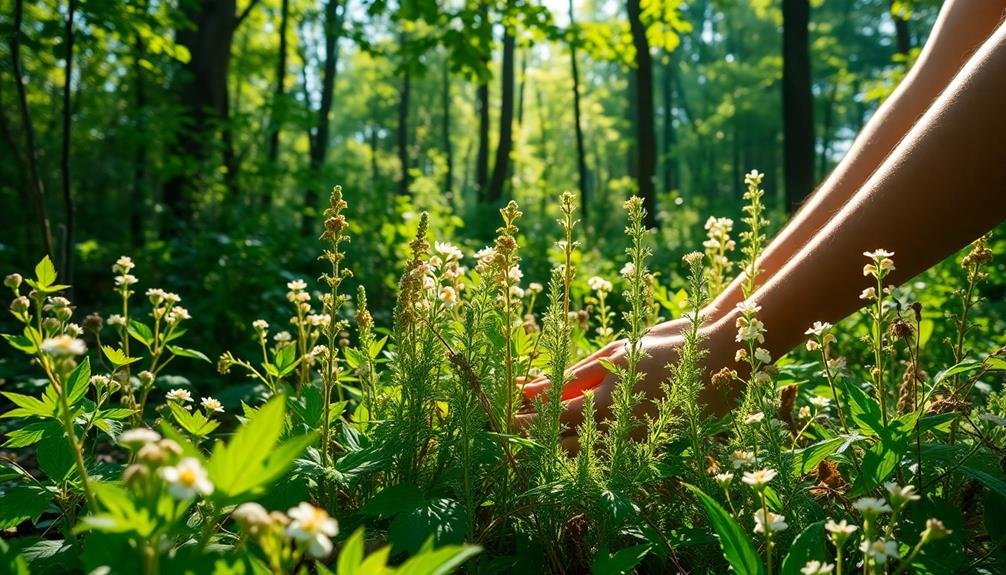
When you set out to select wild herbs, it's essential to know what you're looking for. Familiarize yourself with the plants native to your area, as some herbs can be easily confused with toxic lookalikes. Start by researching commonly used wild herbs like dandelion, nettle, and chamomile. Get a reliable field guide or use a plant identification app to help you distinguish between safe and harmful varieties.
Pay attention to the season and environment where you'll be foraging. Certain herbs thrive in specific conditions, so knowing when and where to look will increase your chances of success. Examine the plants closely; observe their leaves, stems, flowers, and growth patterns. Take note of any distinctive features that can help you identify them accurately.
Always consider the sustainability of your foraging practices. Avoid overharvesting and only take what you need, ensuring the plant can continue to thrive in its habitat.
Harvesting Techniques
When you're ready to harvest wild herbs, knowing the best foraging locations can make all the difference.
You'll also want to take into account seasonal harvesting tips to guarantee you pick at the right time.
Best Foraging Locations
In the heart of nature, you'll find the best foraging locations for wild herbs, which can greatly enhance your tea-making experience. Look for areas with a rich diversity of plant life, such as woodlands, meadows, and along riverbanks. These environments often host a variety of herbs like nettle, mint, and chamomile.
Pay attention to the edges of forests and fields, where sunlight filters through, creating ideal conditions for growth. You'll also want to explore abandoned lots and roadside verges; these locations can surprise you with hidden gems.
Be certain to visit early in the morning or late in the afternoon, when dew settles on the leaves, making herbs easier to spot and collect.
While exploring, remember to observe local regulations and respect private properties. Harvesting from clean, unpolluted areas will guarantee that your tea is safe and flavorful.
Use a good field guide or an app to identify the herbs correctly, and always forage with a friend if you're unsure. Soon, you'll have a treasure trove of wild herbs, ready to brew into a delightful cup of tea that reflects the essence of the landscape you've foraged from.
Seasonal Harvesting Tips
As you gather your wild herbs, knowing the best times to harvest can greatly enhance the quality of your tea. Each season offers unique advantages for foraging, so timing is key.
In spring, vibrant new growth emerges; this is the perfect time to collect tender leaves and young shoots. Herbs like nettle and dandelion are at their peak, bursting with fresh flavors.
Summer is all about flowering herbs. You'll want to harvest them just before they fully bloom for ideal taste. Think of chamomile and lemon balm, which offer a delightful aroma and robust flavor when picked at their prime.
As autumn arrives, focus on roots and seeds. Plants like burdock and chicory are ready for digging, providing rich, earthy flavors that can deepen your tea's profile.
In winter, while most herbs are dormant, you can still forage for dried leaves and seeds. Look for hardy plants that withstand cold weather and collect them for a unique winter brew.
Sustainable Harvesting Practices
Sustainably harvesting wild herbs is vital for preserving the ecosystem and guaranteeing that these natural resources remain abundant for future generations. When you forage, it's essential to follow best practices that respect nature. Start by identifying the plants accurately, as some may be endangered or protected.
Next, only take what you need—this helps maintain the population of the herbs. Aim to harvest no more than 25% of a patch at a time. Rotate your harvesting spots to prevent over-exploitation. Remember to leave some flowers and seeds behind so the plants can reproduce.
Here's a table to guide your sustainable harvesting practices:
| Practice | Why It Matters | Emotional Connection |
|---|---|---|
| Identify correctly | Protects species and biodiversity | Feel a sense of responsibility |
| Take only what you need | Guarantees herbs thrive for future use | Connect with nature's abundance |
| Leave some behind | Supports the plant's lifecycle | Cultivate respect for ecosystems |
| Rotate your spots | Prevents depletion of specific areas | Develop a deeper relationship with nature |
| Educate others | Spread awareness and promote sustainability | Inspire community stewardship |
Cleaning Your Herbs
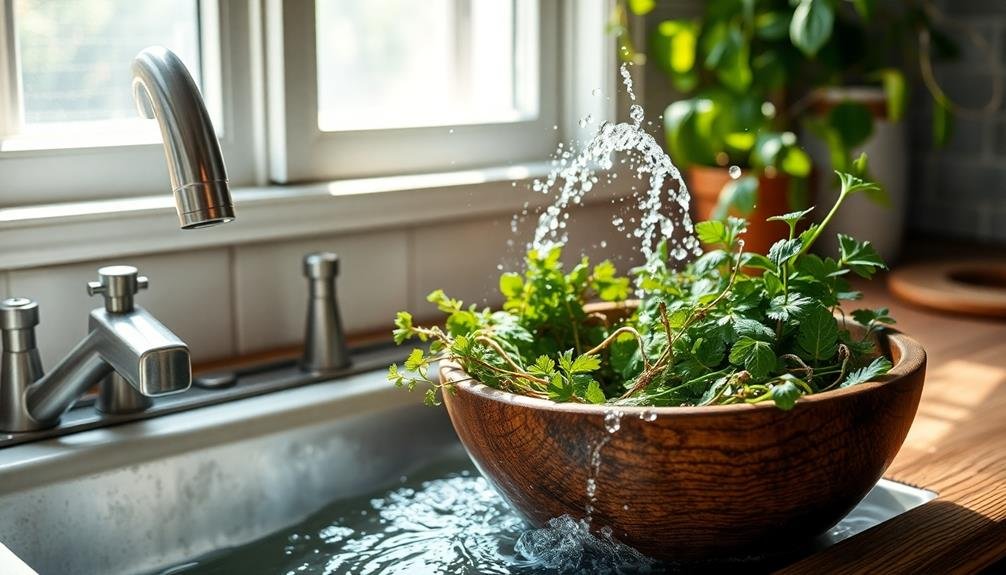
Once you've harvested your herbs, it's essential to clean them properly.
Rinse your herbs under cool water to remove any dirt or debris, then gently pat them dry with a clean towel.
This step guarantees you're left with only the freshest and cleanest ingredients for your tea.
Rinse and Dry Herbs
Cleaning your herbs is an essential step in preparing wild herb tea that guarantees the best flavor and safety. After foraging, you'll want to give your herbs a good rinse to remove any dust, dirt, or insects.
Here's how to effectively clean and dry your herbs:
- Use cold water: Rinse your herbs under cool running water to avoid wilting.
- Gentle handling: Be careful not to bruise the leaves while rinsing; this helps preserve their oils and flavors.
- Soak if necessary: For particularly dirty herbs, you can soak them in a bowl of water for a few minutes before rinsing.
- Dry properly: Shake off excess water and lay the herbs flat on a clean towel or paper towel to air dry.
- Avoid heat: Don't use heat to dry your herbs, as this can alter their flavor and potency.
Once your herbs are clean and dry, they're ready for the next step in your wild herb tea journey.
Remove Unwanted Debris
After rinsing your herbs, it's important to remove any unwanted debris that might've snuck in during foraging. Take a good look at your freshly washed herbs; you might find dirt, twigs, or even small insects hiding among the leaves. These can affect the flavor and aroma of your tea, so it's vital to get rid of them.
Start by gently spreading the herbs out on a clean, dry surface. Use your fingers to sift through the leaves, picking out any visible debris. If you spot stubborn dirt, a soft brush can help dislodge it without damaging the herbs.
For herbs with tightly packed leaves, like mint or thyme, carefully open them up to inspect for hidden debris.
Once you've removed the obvious contaminants, consider a final inspection. If you're particularly sensitive to cleanliness, a quick rinse under cool water can help. Just make sure to dry them thoroughly afterward, as excess moisture can lead to mold.
Drying Methods
Drying herbs is an essential step in preserving their flavors and beneficial properties, guaranteeing you can enjoy wild herb tea long after the harvest season.
You've got several methods to choose from, each with its own benefits. Here's a quick guide to help you decide which one suits your needs best:
- Air Drying: Simply tie herb bundles and hang them in a cool, dark place with good airflow. This method retains the most flavor.
- Oven Drying: Place herbs on a baking sheet in a low-temperature oven (around 180°F or 82°C). Keep the door slightly ajar to let moisture escape.
- Dehydrator: If you have a food dehydrator, it's a great option. Set it to the appropriate temperature for herbs, usually around 95°F (35°C).
- Microwave Drying: For a quick option, place herbs between two paper towels and microwave in short bursts. Be careful not to overdo it!
- Sun Drying: If you live in a hot climate, spread herbs out on a screen or tray in direct sunlight, turning them regularly.
Whichever method you choose, make certain that your herbs are completely dry before storing them for the best flavor in your tea!
Infusion Techniques

When it comes to brewing wild herb tea, mastering infusion techniques is key to revealing the full potential of your dried herbs.
Start by selecting the right herbs based on your desired flavor and benefits. Use a combination of leaves, flowers, or roots to create a balanced infusion.
Next, measure your herbs. A general rule of thumb is one teaspoon of dried herbs per cup of water. Adjust this based on your taste preference.
Bring your water to a boil, then let it cool slightly—ideal temperatures vary by herb, but aim for around 190°F for most.
Place your herbs in a teapot or a heatproof container, then pour the hot water over them. Cover the vessel to trap essential oils and flavors.
Let the mixture steep for 5 to 15 minutes, depending on the herbs used—delicate flowers need less time, while sturdier roots can steep longer.
Once steeped, strain the liquid into your cup, discarding the herbs. Enjoy your infusion as is, or let it cool for an invigorating iced herbal tea.
Flavor Enhancements
To elevate the taste of your wild herb tea, consider incorporating natural flavor enhancements that complement the herbal base.
These additions can transform your brew into a delightful experience, bringing out unique flavors and aromas that make each sip enjoyable. Here are some ideas to enhance your tea:
- Citrus Zest: A bit of lemon, lime, or orange zest can brighten the flavors and add a rejuvenating twist.
- Honey or Maple Syrup: Sweeteners like honey or maple syrup can balance the earthiness of the herbs and provide a comforting touch.
- Spices: Try adding a pinch of cinnamon, ginger, or cardamom for warmth and depth. These spices can introduce a cozy element to your tea.
- Fresh Mint: A few sprigs of fresh mint can invigorate your blend, offering a cool and invigorating aftertaste.
- Vanilla Extract: A drop of pure vanilla extract can add a rich, sweet note that enhances the overall flavor profile.
Experiment with these enhancements to find combinations that suit your palate.
The right balance won't only elevate your wild herb tea but also make the brewing process even more enjoyable.
Storing Your Blends

Properly storing your wild herb tea blends is essential for maintaining their flavor and potency. Once you've carefully foraged and prepared your herbal treasures, you want them to last as long as possible. Begin by choosing airtight containers made of glass or dark-colored plastic, which protect from light and moisture. Label each container with the herb name and date of storage, ensuring you know what you have on hand.
Here's a quick guide to help you store your blends effectively:
| Storage Method | Container Type | Ideal Conditions |
|---|---|---|
| Short-term | Airtight jars | Cool, dark place |
| Long-term | Vacuum-sealed bags | Freezer |
| Loose herbs | Paper bags | Dry, ventilated area |
| Blends | Glass jars | Away from heat |
To keep your herbs fresh, avoid opening containers frequently. Instead, take what you need and reseal tightly. With these simple storage tips, your wild herb tea blends will be ready to delight your senses whenever you need them. Enjoy the journey from forage to cup!
Frequently Asked Questions
Are There Any Poisonous Herbs to Avoid While Foraging?
Yes, you should be cautious while foraging. Some poisonous herbs, like hemlock and foxglove, can be deadly. Always research before you forage, and if you're unsure, don't hesitate to consult an expert or guide.
How Can I Identify Herbs Without a Guidebook?
To identify herbs without a guidebook, observe their leaves, flowers, and growth patterns. Use your senses—smell and touch matter. Consult online resources or apps, and connect with experienced foragers for hands-on learning and tips.
Can I Use Dried Herbs Instead of Fresh Ones?
Yes, you can use dried herbs instead of fresh ones. Just remember, dried herbs are more concentrated, so you'll need less. Adjust your measurements to enhance flavor and balance your tea's overall taste. Enjoy experimenting!
What Are the Best Times of Year for Foraging?
The best times for foraging vary by region, but generally, spring and early summer offer a bounty of fresh growth. In fall, you can find seeds and berries. Just be mindful of local regulations and seasonal changes.
How Do I Know if My Tea Is Safe to Drink?
To guarantee your tea's safe to drink, always identify herbs accurately, avoid toxic look-alikes, and check for contaminants. If unsure, research extensively or consult an expert before brewing and consuming your herbal creations.
In Summary
Now that you've explored these seven wild herb tea techniques, you're ready to create your own unique blends from foraging to brewing. Embrace the thrill of harvesting and experimenting with flavors, all while respecting nature. Remember to clean and dry your herbs properly for the best taste, and don't forget to store your blends safely. With practice, you'll develop your own signature teas that reflect the wild beauty around you. Happy brewing!

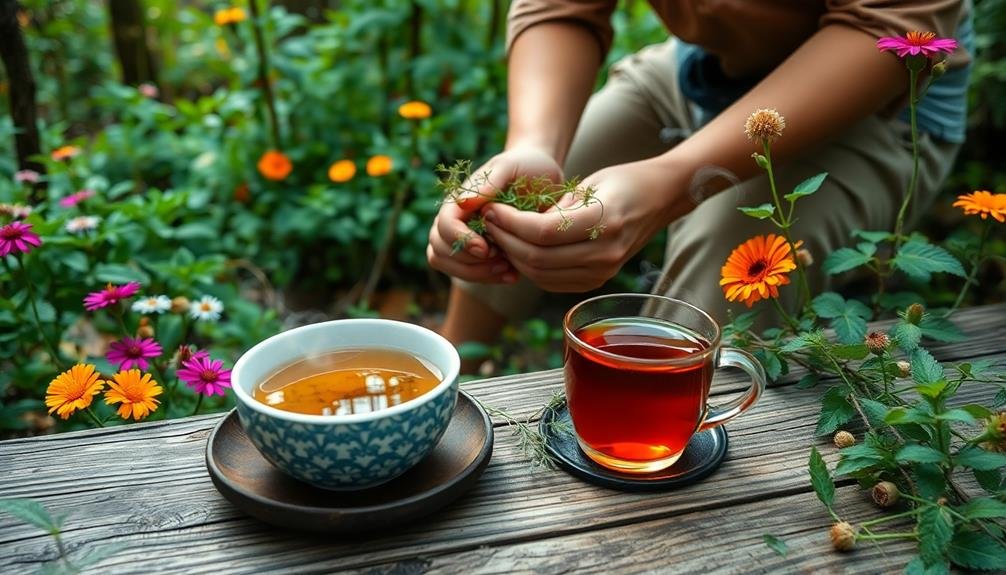
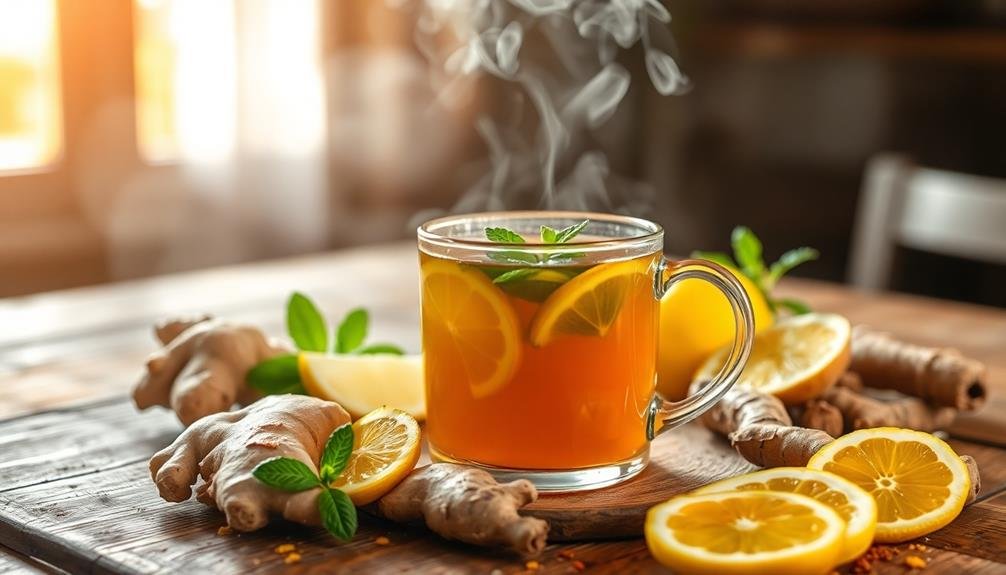
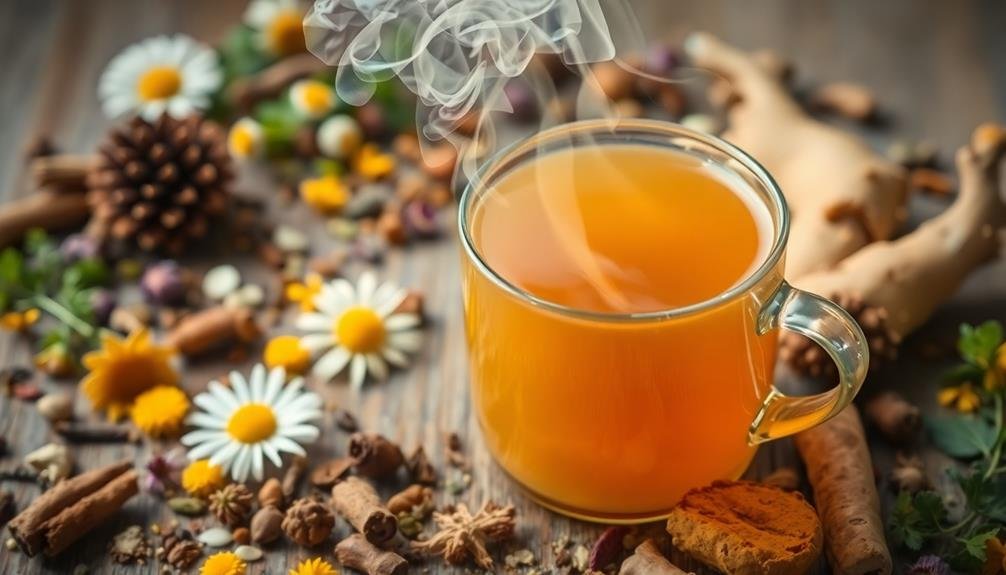
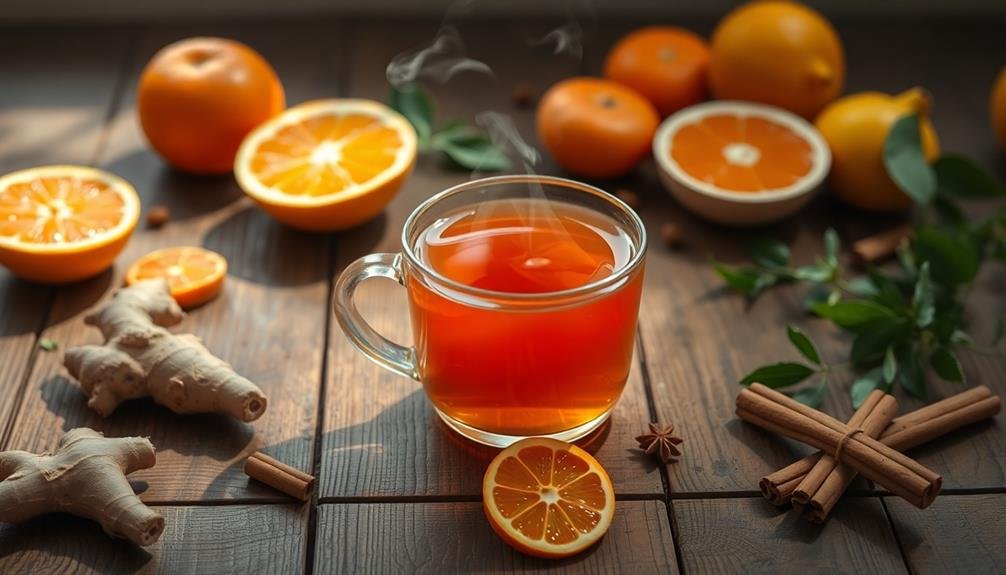
Leave a Reply